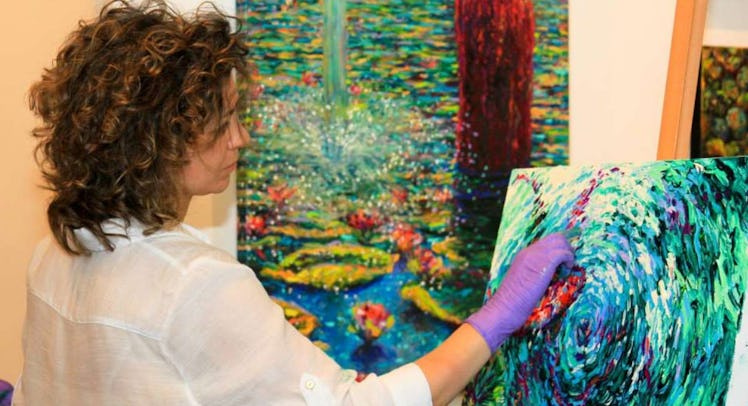The World’s Best Finger Painter Wants You To Stop Praising Your Kid
Professional finger painter Iris Scott gives her five tips to helping your kid master the surprisingly complex art form.

When you think of finger painting, you likely imagine a kindergarten classroom filled with 5-year-olds mindlessly smudging colors everywhere except their canvas. It’s messy. It’s chaotic. It’s a scene that would make even Jackson Pollack call time-out. What you probably don’t think of is Iris Scott, but you should. An artistic anomaly, the 33-year-old artist is the most prolific finger painter in the world, having built a career out of creating works of fine art with nothing but oil paint and her two hands.
Finger painting is often seen as asloppy and abstract pursuit, but Iris’ work is meticulous and vibrant; upon first glance it’s hard to believe it’s been done without a brush. Iris didn’t start with fingers alone: she built up a base of techniques in college before stumbling across the digit-friendly medium while studying in Taiwan. She adored the freedom the artform offered and decided to pursue it full time. Given Scott’s unique skillset makes, it only made sense to ask her for her fingerpainting tips. Here’s how she suggests transforming your kids in master manipulators of paint.
Start With a Pencil and Ruler
Finger painting might be something most kids try in the age range of 3-5, but it’s actually a pretty complex art form. If your kid wants to get into it, Iris suggests they start with something simple: grab a pencil and learn to draw.
“Harnessing a graphite pencil versus moving paints directly with your fingers is a chasm of difference.” In other words, it teaches your kid control. Scott also emphasizes using a ruler to teach your kid how to make purposeful, exact movements. “For drawing, the ruler is like training wheels. You can eventually move past it, but it helps your learn.”
Just Blue It
Picasso had a Blue Period and, according to Iris, so should your kids. She says the best finger painting starter kit is a whole lot of blue paint and some good old-fashioned reckless abandon. “Give them blue and let them go wild. Get different shades,” she says. “Whatever mess they make, it’ll turn out to be a beautiful, water-y abstract painting. Then you can help them develop their skills if that’s what they want to do.”
Copy Stuff
Steve Jobs once said that Pablo Picasso once said, “Good artists copy. Great artists steal.” Ironically, Picasso may have stolen that quote, but, regardless, Iris agrees that copying is important for art. And while your kid may want to immediately get into creating original works of art that will one day hang in museums or living rooms of rich people who want their friends to know they like art, you’re going to want to encourage your kid to start by trying to imitate simple, straightforward stuff.
“Encourage them to copy,” Iris insists “That’s what the professionals do. Copying gets a bad rap. We create individual pieces, but we also trace and copy. For kids, especially, it teaches form and technique.”
Find the Right and Wrong in Art
Art may be subjective, but Iris insists it’s not as objective as people think. And it’s especially not as subjective as parents pretend it is when their kids mess up. “If your kid was learning math, and they told you 2+2=5, you wouldn’t say, ‘What a terrific answer! You’re so unique!’”
Iris says that despite what most parents may think, kids like seeing tangible improvement in their work. Art can obviously be left up to individual interpretation, but that doesn’t mean there isn’t right or wrong. Iris says, “Art can get abstract, but first they need to know how to draw.”
Don’t Give Out False Praise
Iris understands that parents want encourage their kids to have confidence to pursue their passions, and so they’ll often tell their kid everything they do is amazing. But Iris says that approach is “pure crap.”
“Kids are smart. They can sense hollow praise,” she says. “If they are trying to draw a dog, and it’s way off, it doesn’t help to say it’s ‘modern’ or ‘cool.’”
Iris obviously isn’t saying you should mock your kid or discourage them, and they do deserve credit for trying. But kids appreciate it when people are honest about where they can improve their work.